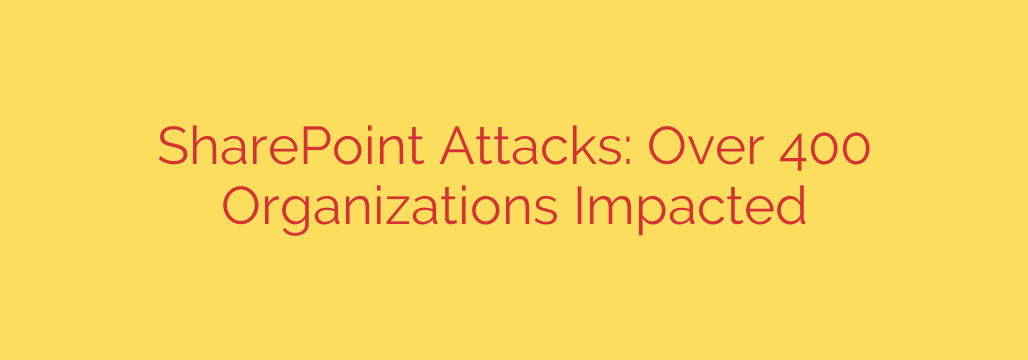
Critical SharePoint Vulnerability Actively Exploited: How to Protect Your Organization Now
A severe vulnerability in Microsoft SharePoint Server is being actively exploited by cybercriminals, putting the sensitive data of hundreds of organizations at risk. This critical security flaw allows attackers to gain complete administrative control over targeted servers, leading to significant data breaches and network-wide compromise.
Understanding the threat and taking immediate action is crucial for any organization utilizing on-premise SharePoint environments.
The Anatomy of the Attack: A Dangerous Exploit Chain
The attack leverages a combination of two distinct vulnerabilities to achieve its goal. The primary flaw, tracked as CVE-2023-29357, is a privilege escalation vulnerability. In simple terms, it allows an unauthenticated attacker on the internet to elevate their access rights and gain administrator-level privileges on a vulnerable SharePoint server. The scariest part? This requires no user interaction and no prior authentication.
Once an attacker gains admin access, they chain this exploit with a second vulnerability, CVE-2023-24955. This second flaw is a remote code execution (RCE) bug that, when used by an authenticated administrator, allows them to run malicious code on the server.
The attack unfolds in two devastating steps:
- Gaining Access: The attacker exploits CVE-2023-29357 to silently make themselves a site administrator.
- Executing Code: Now with admin rights, they exploit CVE-2023-24955 to inject and run their own commands, effectively seizing control of the server.
This gives them the power to steal data, install ransomware, or use the compromised server as a launchpad to attack other systems within your network.
What’s at Stake? The Impact of a SharePoint Breach
A compromised SharePoint server is a goldmine for attackers, as it often houses a company’s most valuable and sensitive information. The consequences of a successful breach are severe and far-reaching.
- Massive Data Theft: Attackers can exfiltrate confidential documents, financial records, employee data, intellectual property, and strategic plans.
- Ransomware Deployment: Once in control, cybercriminals can encrypt the entire SharePoint database and all connected files, demanding a hefty ransom for their return.
- Corporate Espionage: A rival or state-sponsored actor could gain persistent, undetected access to your internal communications and strategic documents.
- Full Network Compromise: The SharePoint server can be used as a foothold to move laterally across your network, compromising other critical systems like domain controllers and databases.
The attacks observed in the wild involve attackers implanting a malicious file that, when executed, downloads further malware. This often leads to the deployment of backdoors for long-term access and control.
Your Action Plan: Essential Security Measures to Implement Immediately
Given the critical nature of this vulnerability and its active exploitation, immediate action is required. If your organization runs Microsoft SharePoint Server 2016 or 2019, you must assume you are a target.
1. Patch Your Servers Immediately
Microsoft released security patches for CVE-2023-29357 in its May 2023 Patch Tuesday updates and for CVE-2023-24955 in its May and June updates. Applying these patches is the single most important step you can take to protect your organization. Do not delay this process.
2. Hunt for Signs of Compromise
Even after patching, you must investigate whether your servers have already been compromised. Look for the following indicators:
- Suspicious Processes: Check for unexpected
PowerShell.exeorcmd.exeprocesses running under the SharePoint service account. - Unusual Files: Scrutinize SharePoint server directories for unknown or recently modified
.aspxfiles, especially in directories accessible to the public. Attackers often drop web shells for persistent access. - New, Unrecognized User Accounts: Review your SharePoint site administrators for any accounts that were not created by your IT team.
3. Harden Your SharePoint Configuration
Security is about layers. Beyond patching, review your server’s configuration. Disable anonymous access for all web applications unless it is absolutely essential for business operations. Limiting public-facing exposure dramatically reduces your attack surface.
4. Enhance Security Monitoring
Ensure you have robust logging and monitoring in place for your SharePoint environment. Forwarding server logs to a security information and event management (SIEM) system can help you detect anomalous activity quickly and respond before significant damage is done.
The threat posed by this SharePoint exploit chain is not theoretical—it is happening now. Proactive patching and vigilant security monitoring are not just recommended; they are essential to safeguarding your organization’s critical data and infrastructure.
Source: https://go.theregister.com/feed/www.theregister.com/2025/07/23/microsoft_sharepoint_400_orgs/








